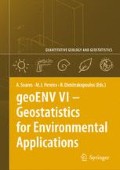Abstract
The study was devoted to the identification of the spatial parameters that contribute mainly to the assessment of the vulnerability of cereals in the context of accidental discharges of radioactivity into the environment. Linking an agronomical model and a radioecological model highlighted first that the flowering date was the main parameter, since it determines the beginning of an exponential transfer of contaminants from the leaves of cereal plants to the edible part, the grain. Secondly, yield also appeared to be an important parameter as it allows the quantification of the number of contaminated products. The spatial statistical analysis performed on the yield data allowed the creation of vulnerability maps with clear spatial trends, which can facilitate the management of risks associated with radioactive contamination of cereals during the post-accidental phase.
Access this chapter
Tax calculation will be finalised at checkout
Purchases are for personal use only
Preview
Unable to display preview. Download preview PDF.
References
Agreste (1988) Recensement général de l’agriculture. Agreste(ed), France
Agreste (2000) CD ROM Recensement agricole 2000 - La fiche comparative., Eds Agreste France
Angeletti L, Levi E (1997) Etudes comparatives des facteurs de transfert de l’eau, de l’iode et du strontium sur le ray-grass et le tréfle. Rapport CEA-R-4960, Commissariat á l’Energie Atomique, Saclay, France
Anselin L (1995) Local Indicators of Spatial Association — LISA, Geographical Analysis Vol 27. pp 93–115
Brisson N, Mary B, Ripoche D, Jeuffroy MH, Ruget F, Nicoullaud B, Gate P, Devienne F, Antonioletti R, Dürr C, Richard G, Beaudoin N, Recous S, Tayot X, Plénet D, Cellier P, Machet JM, Meynard JM, Delécolle R (1998) STICS: a generic model for the simulation of crops and their water and nitrogen balances. I. Theory and parameterization applied to wheat and corn. Agronomie, 18: 311–346
Brisson N, Mary B (2002) STICS : Notice concepts et formalismes. Version 5.0. (eds) INRA, France
Chamberlain AC (1970) Interception and retention of radioactive aerosols by vegetation. Atmos Environ 4: 57–78
Hoffman FO (1989) Pasture grass interception and retention of 131I, 7Be and insoluble microspheres deposited in rain. OAK-RIDGE Laboratory, Environmental Sciences Division.
Jacquez GM, Goovaerts P, Rogerson P (2005) Space-Time intelligence Systems: Technology, applications and methods. J Geo Syst 7: 1–5
Mercat-Rommens C, Renaud P (2005) From radioecological sensitivity to risk management: the SENSIB project, second international conference radioactivity in the environment, nice.
Moran PAP (1950) Notes on continuous stochastic phenomena, Biometrika 37: 17–23
Mourlon C, Calmon P (2002) ASTRAL: a code for assessing situations after a nuclear accident. 12th annual meeting of SETAC Europe, Vienna 37: pp 12–16
Müller H, Pröhl G (1993) ECOSYS-87: a dynamic Model for assessing radiological consequences of nuclear accidents. Health Phy 64(3): 232–252
Author information
Authors and Affiliations
Editor information
Editors and Affiliations
Rights and permissions
Copyright information
© 2008 Springer Science+Business Media B.V.
About this chapter
Cite this chapter
Mercat-Rommens, C., Metivier, JM., Briand, B., Durand, V. (2008). How Spatial Analysis Can Help in Predicting the Level of Radioactive Contamination of Cereals. In: Soares, A., Pereira, M.J., Dimitrakopoulos, R. (eds) geoENV VI – Geostatistics for Environmental Applications. Quantitative Geology and Geostatistics, vol 15. Springer, Dordrecht. https://doi.org/10.1007/978-1-4020-6448-7_6
Download citation
DOI: https://doi.org/10.1007/978-1-4020-6448-7_6
Publisher Name: Springer, Dordrecht
Print ISBN: 978-1-4020-6447-0
Online ISBN: 978-1-4020-6448-7
eBook Packages: Earth and Environmental ScienceEarth and Environmental Science (R0)

